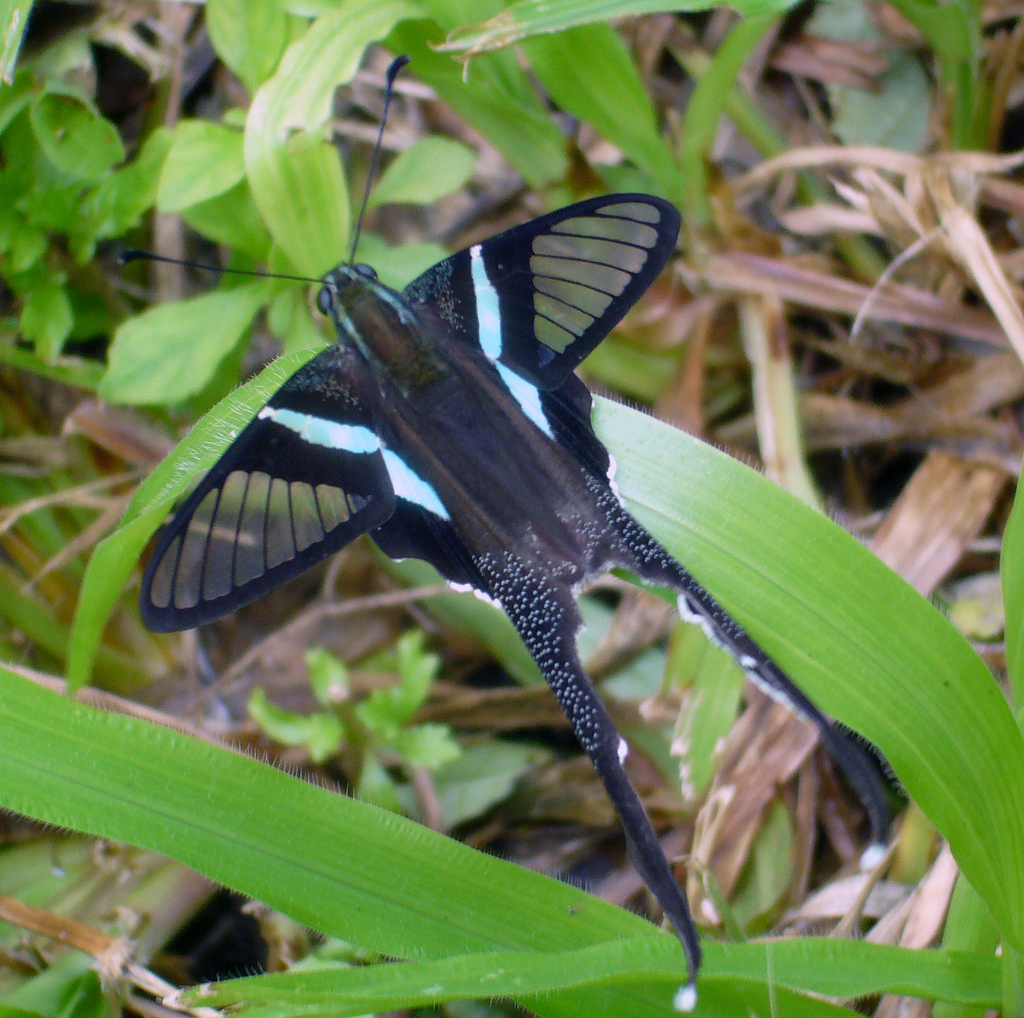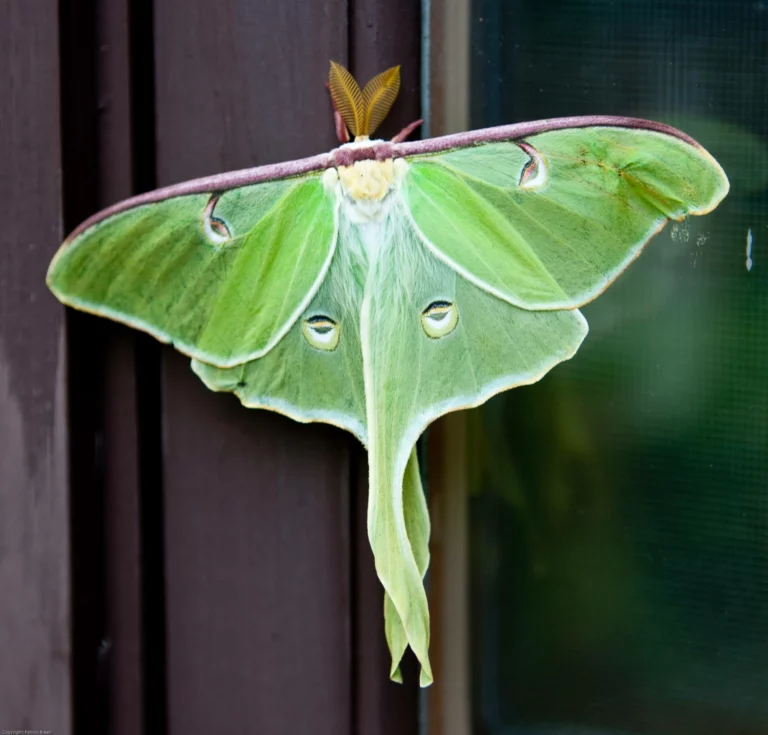Moths do not have tails in the same way that some birds and dinosaurs have tail feathers or other animals have long, protruding tails. Moths are insects, and their bodies are typically divided into three main parts: the head, thorax, and abdomen. They have six legs, two antennae, and often wings covered in scales.
What may be causing confusion is the appearance of some moth species, which have extensions at the end of their hindwings that can resemble tails. These extensions are not true tails but rather are called “tornal lobes” or “wingtails.” Tornal lobes are usually found in certain moth families, such as the Geometridae (geometer moths) and some species of swallowtail moths.
How is a moth’s body structured?
Moths belong to the insect order Lepidoptera, and their basic body structure consists of three main parts:
- Head: The head of a moth contains essential sensory organs, including compound eyes for vision, two segmented antennae for detecting chemical cues and environmental stimuli, and a proboscis (a long, tubular mouthpart) used for feeding on nectar or other liquids.
- Thorax: The thorax is the middle segment of the moth’s body, and it is where the wings and legs are attached. Moths have three pairs of jointed legs used for walking and gripping surfaces.
- Abdomen: The abdomen is the posterior part of the moth’s body and contains many vital organs, including the digestive system, reproductive organs, and respiratory structures (spiracles).
Description of Moth Wings and Scales

Wings: Moths have two pairs of wings, one forewing and one hindwing, which are typically covered in overlapping scales. These wings are essential for flight and come in various shapes, sizes, and colors depending on the species. Moth wings are membranous structures that are powered by strong flight muscles attached to the thorax.
Scales: The scales covering moth wings are tiny, overlapping structures that give moths their characteristic powdery or scaly appearance. These scales can vary in color and pattern, often serving as camouflage or visual cues for potential mates.
Moreover, scales are easily dislodged and can create a cloud of fine particles when a moth is handled or disturbed.
Overview of Moth Antennae
Moth antennae are highly sensitive sensory organs that play a crucial role in the moth’s ability to navigate its environment. Key points about moth antennae include:
- Antennae are typically feathery or thread-like, with many segments.
- They are covered in sensory hairs and receptors that can detect chemical signals (pheromones) released by other moths, helping them locate mates.
- Antennae are also used for detecting environmental cues such as air currents, temperature changes, and obstacles during flight.
Number of Legs in Moths
Moths, like all insects, have six legs. These legs are joined and attached to the thorax. They serve various functions, including walking, gripping surfaces, and sometimes foraging for food.
Furthermore, the legs of moths can vary in structure, with adaptations for specific ecological niches. For example, some moths have legs adapted for clinging to leaves, while others may have legs modified for perching on flowers or tree bark.
What is the purpose of tornal lobes in moths?
Tornal lobes are specialized wing extensions or projections found at the posterior edge of the hindwings of certain moth species. These structures are distinct from the main wing structure and are typically elongated and pointed. Tornal lobes are composed of the same wing membrane material as the rest of the wing but often have different coloration or patterning.
Purpose and Function of Tornal Lobes
Tornal lobes serve various purposes and functions in moths, including:
- Flight Stability: Tornal lobes contribute to the aerodynamic stability of moths during flight. By altering the airflow around the hindwings, they help in maintaining steady flight and reducing turbulence.
- Predator Confusion: Some tornal lobes mimic the appearance of antennae or other appendages, potentially confusing predators like birds or spiders.
In addition, when a predator attempts to attack, they may target the tornal lobes instead of the moth’s body, allowing the moth a chance to escape.
- Camouflage: In certain species, tornal lobes may resemble other objects or mimic features in the environment, providing camouflage and making it harder for predators to detect the moth while at rest.
- Mating Signals: Tornal lobes can also play a role in mate selection and communication.
Additionally, they may be used as visual cues during courtship displays, with males displaying their tornal lobes to attract females.
Moth Families with Tornal Lobes
Tornal lobes are not present in all moth species but are more commonly found in certain families, including:
Geometer moths are known for their distinctive tornal lobes. These lobes are often long and slender, contributing to their common name “inchworm moths.” Geometer moths use their tornal lobes for precise and controlled flight.
In addition, some species of sphinx moths possess small, pointed tornal lobes that aid in their rapid and agile flight. Swallowtail moths, although not as well-known for tornal lobes as the previous families, may also exhibit these structures.
How do tornal lobes differ from true tails in animals?
Tornal lobes represent an intriguing adaptation in the world of insects and contribute to the diverse range of strategies that moths employ for survival.
To clarify the distinction between true tails and tornal lobes in moths, consider the following:
True Tails: True tails are typically found in vertebrate animals, such as some birds and reptiles. These tails are extensions of the vertebral column and are composed of bone and muscle.
Furthermore, true tails often serve various functions, including balance, communication, and defense. In birds, for instance, tails are essential for stability during flight.
Tornal Lobes: Tornal lobes, on the other hand, are exclusive to certain moth species and are extensions of the wing membrane.
In addition, they are not composed of bone or muscle but are part of the moth’s wing structure. Tornal lobes primarily serve functions related to flight stability, predator evasion, and sometimes mate attraction, as explained earlier.
Addressing Common Misconceptions
There are several common misconceptions about moths and their “tails” that should be addressed:
Moths Have Bird-Like Tails: Some people may mistakenly believe that moths have tails similar to those of birds. This is not the case. Moths do not have vertebrate tails; instead, they have wing extensions (tornal lobes) that serve different purposes.
Moth Tails Are Used for Communication: While true tails in animals like peacocks are often used for communication and courtship displays, tornal lobes in moths primarily aid in flight stability and predator avoidance. They are not used for communication between moths.
All Moths Have Tornal Lobes: Not all moth species have tornal lobes. Tornal lobes are more common in certain families, as mentioned earlier, but they are not a universal feature of all moths.
Tornal Lobes Are Defensive Weapons: Tornal lobes are not defensive weapons like the stingers of bees or the tails of some scorpions. While they might deter some predators by confusing them, tornal lobes primarily contribute to flight and predator evasion rather than direct defense.
Tornal Lobes Are Fragile and Easily Detached: Tornal lobes are relatively robust structures and are not as fragile as moth scales. While they can be damaged if handled roughly, they are not designed to be easily detached from the moth’s wings.
How do tornal lobes contribute to moth survival?

Tornal lobes represent an intriguing adaptation in the world of moths, allowing them to navigate their environments more effectively, avoid predation, and increase their chances of successful reproduction and survival in a highly competitive ecosystem.
Tornal lobes play several important roles in the behavior and ecology of moths:
Flight Stability: Tornal lobes are critical for flight stability. They help moths maintain precise control over their movements, especially during agile and maneuverable flight, such as when evading predators or navigating complex environments. The extensions alter airflow patterns, reducing turbulence and aiding in steady flight.
Predator Confusion: Tornal lobes can confuse predators, particularly those that use visual cues to locate prey. When a moth is under attack, its tornal lobes may resemble antennae or other vulnerable body parts, diverting the predator’s attention and potentially allowing the moth to escape. This is a form of mimicry, where the moth appears less appetizing or harder to catch.
Camouflage and Disguise: In some moth species, tornal lobes are adapted to mimic natural elements in their environment, such as leaves or twigs. This camouflage can make moths less visible to potential predators when they rest on surfaces like tree bark or foliage.
Furthermore, tornal lobes contribute to overall body shape and coloration, enhancing the moth’s ability to blend in with its surroundings.
Mate Attraction: In certain cases, tornal lobes may have a role in mate attraction and courtship behavior. Male moths may display their tornal lobes as part of intricate courtship rituals to signal their fitness and attractiveness to potential mates.
Possible Advantages of Tornal Lobes in Moth Survival
Tornal lobes provide several advantages that contribute to the survival of moth species:
Increased Survivability: By enhancing flight stability and evading predators, tornal lobes improve a moth’s chances of surviving in its natural habitat. Moths with effective escape strategies are more likely to reproduce and pass on their genes.
Reduced Energy Expenditure: Efficient flight is essential for foraging and finding mates. Moths with well-developed tornal lobes can conserve energy by flying more efficiently, which can be crucial for their overall fitness.
Diverse Ecological Niches: Tornal lobes allow moths to occupy a wide range of ecological niches. Whether it’s precise maneuvering in dense forests or camouflage on tree trunks, these adaptations enable moths to exploit various environments and resources.
Predator Avoidance: The ability to confuse and deter predators through tornal lobes can mean the difference between life and death for a moth. Predation is a significant threat in the lives of moths, and any advantage that aids in avoidance is a valuable survival trait.
FAQ’s
Why do luna moths have tails?
Luna moths have tails to help them evade predators like bats. The tails can confuse attackers, making it harder to catch the moth’s body.
Does a moth have a heart?
Yes, moths, like other insects, have a tubular heart that pumps hemolymph (insect “blood”) throughout their body.
Why do moths not bleed?
Moths do not have red blood like humans; they have a colorless fluid called hemolymph. When injured, hemolymph can leak out, but it doesn’t “bleed” as mammals do.
Can I touch a Luna moth?
It’s best to avoid touching Luna moths or any other wild insects to minimize stress and potential harm to them.
Is it rare to see a Luna moth?
Yes, seeing a Luna moth in the wild can be considered rare as they are nocturnal and have a relatively short adult lifespan, typically around one week.
What color is a butterfly’s blood?
A butterfly’s “blood,” or hemolymph, is clear or pale yellowish-green and lacks the red pigment (hemoglobin) found in human blood.
Can moths hear you?
Moths do not have ears like mammals but can detect sound vibrations through specialized structures called tympanic organs or hearing organs, which are sensitive to certain frequencies.
Final Words
In summary, we’ve learned a lot about moths and their special body part called “tornal lobes.” These lobes are like extensions on their wings and help moths fly better and stay safe from other animals that might want to eat them.
Moreover, they also use these lobes to hide and find friends. We also cleared up some wrong ideas about moth tails and showed how they’re different from other animals’ tails. We looked at pictures of moths with these special lobes, which helped us see how different they can look.
In the end, moths are fascinating creatures, and their tornal lobes are an important part of their lives. Understanding these things helps us see how amazing nature is and why it’s essential to take care of our environment and all the creatures that live in it.

